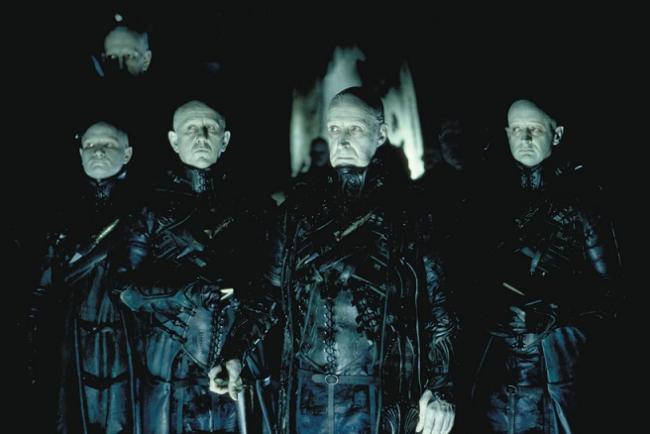‘Dark City’ is classic noir sci-fi
Dark City (1998, Arrow Video, 2 4K Ultra HDs or 2 Blu-rays, NR and R, 111 or 100 min.). Director/co-writer Alex Proyas extraordinary, visionary film had a first script in 1991, but the film idea was constantly rejected until his success with “The Crow” in 1994. These two new releases include both the longer director’s cut and the theatrical version, each on their own disc, with a multitude of extras, both old and new.
The thriller mixes noir with science fiction – astounding science fiction – set in a world of constant night in which most inhabitants cannot remember the last night they have seen daylight or even their parents. In fact, nothing is as it seems, as in this Kafkaesque tale, John Murdoch discovers that the key to his mystery is the presence of pale, bald-headed creatures, the Strangers, who are experimenting with the memories of the humans in the city.
There is more to tell about the Strangers, who include Richard O’Brien (“The Rocky Horror Picture Show,” “Shock Treatment”) as Mr. Hand and Ian Richardson (“Brazil”) as Mr. Book, but that would spoil the film’s extraordinary setting and midnight activities.
The film starts with Murdoch (Rufus Sewell of “A Knight’s Tale,” “The Illusionist,” TV’s “The Diplomat”) waking up naked in a filled bathtub, with no idea how he got there. Wandering into the next room he sees the nude body of a dead woman who has spirals carved into her body. As he is trying to figure out what has gone on, Dr. Daniel Schreber (Kiefer Sutherland of “Flatliners,” TV’s “24”) calls him and says his memory has been erased as part of an experiment. Schreber heads the Strangers’ experimentation.
After finding another body in a phone booth, Murdoch learns he has been staying at a hotel for three weeks and is estranged from his wife Emma (Jennifer Connelly (“A Beautiful Mind,” “Labyrinth”), who he then tries to find. She is a singer in a nightclub.
It turns out the dead woman Murdoch first saw was the sixth victim of a serial killer who preys on prostitutes. That makes Murdoch the subject of a police manhunt, led by Inspector Frank Bumstead (William Hurt of “Broadcast News,” “Lost in Space,” “Altered States”).
One of the main changes in the director’s cut is the omission of the opening narration, which gave too much away.
The director’s cut comes with five (!) audio commentaries, including new ones by director Proyas and Craig Anderson, Bruce Isaacs and Herschel Isaacs, co-hosts of the Film Versus Film podcast. The three archival commentaries are by Proyas (who also does an archival film introduction with Roger Ebert, 4:51), film critic Roger Ebert and co-writers Lem Dobbs and David S. Goyer.
Excellent is a new making-of feature (58:55), which discusses the development troubles and says as many as 80 to 150 Strangers were used in various scenes. Participating are Proyas, producer Andrew Mason, production designers Patrick Tatopoulos and George Liddle, costume designer Liz Keough, storyboard artist Peter Pound and cinematographer Dariusz Wolski. Another strong extra consists of design drawings and storyboards (14:08). There also are two new visual essays: one by film scholar Alexandra West on psychology and latent learning (14:33); the other by film scholar Josh Nelson on the film noir aspects, as an alienated hero tries to make sense of his world (19:50).
The 100-minute theatrical version comes with two archival audio commentaries: one by critic Ebert; the other by Proyas, Dobbs, Goyer, Wolski and Tatopoulos. There also is a 2008 making-of feature (43:26); a 2008 collection of five different perspectives on the themes and meaning of the film (33:41); and an image gallery.
Physical extras include a 60-page perfect-bound collector’s book with new writing by author Richard Kadrey and film critics Sabina Stent, Virant Nehru and Martyn Pedler; a double-sided foldout poster; three postcard-sized reproduction art cards; a postcard from Shell Beach; and Dr. Schreber’s business card. Grade: director’s cut 4.5 stars; theatrical version 3.5 stars; extras 4 stars
Rating guide: 5 stars = classic; 4 stars = excellent; 3 stars = good; 2 stars = fair; dog = skip it
The Invisible Swordsman (Japan, 1970, Arrow Video, Blu-ray, NR, 78 min.). Aimed at a younger audience, which probably accounts for the children’s chorus opening and closing song, as well as some of the unnecessary comedy, the film has fairly decent practical special effects, but has the protagonist basically wastefully misuse his four bouts of invisibility until the final one.
The film was directed by Yoshiyuki Kuroda (“Yokai Monsters: Spook Warfare,” “Lone Wolf and Cub: White Heaven in Hell”) and written by Tetsuro Yoshida (“Samaritan Zatoichi,” 3 “Akado Suzunosuke” films). The cinematographer was Hiroshi Imai (“Zatoichi and the Doomed Man,” “The Haunted Palace”).
In Edo-era Japan, Sanshiro (Osamu Saka) hones his sword-fighting skills at the Kendo Dojo, but he is clumsy and somewhat cowardly. Then his samurai father is killed by the Phantom Thieves, a gang that raids businesses at night.
Bemoaning his father at night, Sanshiro sees him being transported by boat on the Sanzu River to the afterlife. As he attempts to jump in to stop his father, Sanshiro is prevented by a specter known as Shokera. This gatherer of the dead tells Sanshiro to collect Chigo Lily from the mountains, Suppon Mushroom from the steep cliffs and Hondawara Seaweed that washes up on the shore and then boil the three ingredients overnight to create a potion that can render him invisible as he seeks revenge for his father’s murder.
Sanshiro basically wastes his first three usages, including teasing a swordsman who was bothering a female friend of his. He continues to act stupidly when invisible until the final mass battle.
Most of the action takes place at might, probably to make the special effects easier to pull off, but really it makes the film too dark.
The film, which is released for the home video market for the first time outside of Japan, comes with new audio commentary by author and Asian culture expert Jonathan Clements; new interviews with film critic Kim Newman on the history of invisibility in films and literature (15 min.); and with film critic and Japanese cinema expert Jasper Sharp on special effects films (26:36); an image gallery; and a collector’s booklet with new writing on the film by Zack Davisson. Grade: film 2.5 stars; extras 2.75 stars
Gate of Flesh aka Carmen 1945 (Japan, 1988, 88 Films, Blu-ray, NR, 118 min.). This is one of five film adaptations of the 1947 novel by Taijiro Tamura, set during the occupation of Japan by Allied forces. In the shell-shocked, rubble-strewn wasteland of postwar Tokyo, five prostitutes band together to pool their resources to turn the wreck of a burned-out building into a dancehall called Paradise. The five pool their makings -- $2 for just sex, $5 for all night – with 10 percent going to the Paradise fund and the rest shared equally. Paradise really is the dream of one of the women, but the others go along, until they add a sixth member.
One should mention that the building contains an unexploded one-ton bomb, which the women feel would prevent anyone from taking the ruin from them, although, in fact, one yakuza group tries to do so. And while this is the only one of the five adaptations with this ending – in fact, the book has the dancehall established – it does feel very inevitable.
Throughout the film, directed by Hideo Gosha (“The Steel Edge of Revenge,” “Yokio”), the women are also threatened by black marketeers, would-be-pimps and a rival group of prostitutes. The film features one vicious fight between the leaders of the two prostitute groups. There also is some nudity and a couple of murders. Brought into the Paradise group is Colt Shin, a former yakuza leader they find almost dead in the building.
This is the film’s first home video release outside of Japan. Extras include audio commentary by Amber T. and Jasper Sharp; a new film introduction by Earl Jackson (22:09); an interview with Toei Studio tattoo artist Seiji Mouri (11:33; in Japanese); a photo gallery (3:20); and a 24-page collector’s booklet with writing on the film by Irene Gonzalez Lopez and Robin Gatto. Grade: film 3 stars; extras 3.25 stars
Terminus (France, 1987, MVD Rewind Collection, NR or PG, 115 min. or 83 min.). The longer of the two versions is the French release, director Pierre-William Glenn’s director’s cut, while the shorter one is the United States release, amazingly 32 minutes shorter. Even with the longer director’s cut, it is a bit hard to follow the film, which mixes “Mad Max” style attacks with a road race concept that is either not fully explained or hardly shown, and a whole bunch of cloning. In fact, Jurgen Prochnow (“Das Boot,” “Dune” of 1984, “Judge Dredd”) plays three different roles: Sir, who seems to be in charge of everything, the clone scientist/Doctor and one of the truck drivers.
The year is 2037 and evil forces, or race competitors, try to prevent Monster, a large red truck that is computer guided (with movable lips when the computer talks) from reaching its goal. The truck is first driven by Gus (Karen Allen of “Starman,” “Raiders of the Lost Ark”) in the long-distance chase with armored vehicles. If she can reach a place known as End of the Line, she will win her weight in gold.
At End of the Line, the game is closely monitored by its designer, the genetically-engineered child genius Mati (Gabriel Damon), the creation of Doctor, who is working for Sir, who plans to take over the world with artificial people. Gus is captured and fatally tortured, but before she dies, she gives the truck’s access codes to her cellmate, the former soldier Stump, so-named for his metal hand. Stump continues the drive, and is joined by the young slave child Princess (director Glenn’s daughter, Julie). Gradually, Stump discovers that Princess is Mati’s sister and that Mati is attempting to reunite with her as a means of outwitting Sir.
Stump is played by Johnny Hallyday, more famously known as the “French Elvis” for his voluminous music career.
The film is packed with fiery explosions and an excellent car crash that is shown from two angles. There also is a bizarro babies sequence. Mostly, the script lacks cohesion.
The extras are decent and include a new and 2013 combined interview with Prochnow about his career (15:55); a new making-of feature that includes extensive interviews with Glenn’s children, Vincent and Julie, as well as archival interviews (49:29); and a photo gallery (3:03). Grade: film 2 stars; extras 2.75 stars
About this blog:

My music review column, Playback, first ran in February 1972 in The Herald newspapers of Paddock Publications in Arlington Heights, IL. It moved to The Camden Herald in 1977 and to The Courier Gazette in 1978, where it was joined by my home video reviews in 1993. The columns ran on VillageSoup for awhile, but now have this new home. I worked at the Courier Gazette for 29 years, half that time as Sports Editor. Recently, I was a selectman in Owls Head for nine years.




























